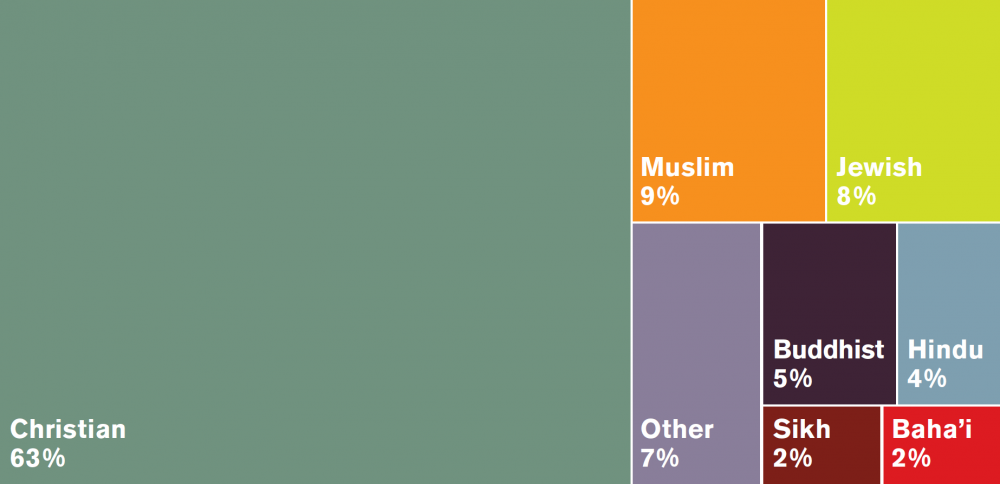Lead chaplains’ calculations for their universities revealed a total of 1032 chaplains, of whom 63% were Christian (including Quakers), 9% were Muslim, 8% Jewish, 5% Buddhist, 4% Hindu, 2% Sikh, 2% Baha’i and 7% ‘other’, as Figure 1 shows.
(In this Executive Summary most percentages are reported to the nearest whole number, for ease of reading. The full report reports these to the nearest decimal point.)

In the ‘other’ category, the largest groups are humanist (1.6%), inter-faith (1.4%) and Pagan (1.4%) chaplains. If distinguished from the general Christian group, Quakers made up 3.7% of chaplaincy roles.
The numbers of chaplains does not give an accurate picture of the amount of chaplaincy work taking place, however. Figure 2 shows the number of chaplaincy roles and the number of full-time-equivalent roles, for each religious group. For each, the number of roles is greater because many chaplains work part-time or occasionally.

Gender and age: Of the 367 chaplains interviewed by telephone, 63% were male, 37% female [One person (0.3%) identified as trans/non-binary/queer]. Two-thirds (66%) were 45-54 or older, and while most were below 65, one in ten (11%) were 65 and over (and two were 85 and older). Women were younger and slightly more likely to be paid than men, suggesting that the world of chaplaincy is becoming more gender equal.
Education and training: Chaplains are highly educated: 98% had at least a Bachelors’ degree and 27% a PhD. 61% had undertaken religious training (e.g. were an ordained minister) and, split by religious group, the Christians were the most likely to have done so. Asked if they held a chaplaincy-specific qualification, only 13% of all chaplains and 20% of lead chaplains said yes. This suggests that despite the existence of chaplaincy courses, the vast majority of chaplains have not been trained specifically as chaplains.
Role title
‘Chaplain’ was by far the most common, mentioned by 317 out of 367 people. For a substantial number the word ‘chaplain’ stood alone or was accompanied by a generic term such as ‘University’ or ‘Duty’ or a term indicating level of commitment or seniority, e.g. ‘Coordinating’, or ‘Honorary’ or ‘Associate’ for volunteers. For 84 it was accompanied by a Christian denomination or grouping such as ‘Free Church chaplain’, with ‘Anglican chaplain’ and ‘Catholic chaplain’ the most common, followed by ‘Methodist’ chaplain. ‘Christian chaplain’ was rare, as the denomination was usually mentioned, whereas for non-Christians termed chaplains, their religion was usually mentioned without denominational subdivisions: ‘Muslim chaplain’, ‘Jewish chaplain’ or ‘Sikh chaplain’. Minority faiths were more commonly called ‘chaplain’ than they were ‘faith advisor’. Whether this represents Christian hegemony or religious diversity is unknown: it may indicate that the originally Christian term ‘chaplain’ is becoming accepted for other faiths, or it may indicate the dominance of Christian terminology.
